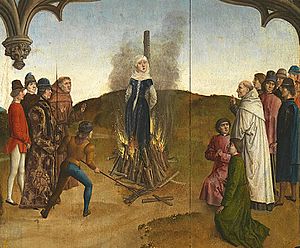Richardis facts for kids
Quick facts for kids Saint Richardis |
|
|---|---|

A depiction of St. Richardis and Herrad of Landsberg in Hohenburg Abbey, Alsace, France.
|
|
| Holy Roman Empress | |
| Born | c. 840 |
| Died | 18 September c. 895 (aged c. 55) Andlau, Alsace |
| Venerated in | Eastern Orthodox Church Roman Catholic Church |
| Major shrine | Andlau Abbey |
| Feast | 18 September |
| Attributes | dressed in Imperial robes with crown and palm, and surrounded by flames; dressed as a nun, with crown laid aside, and burning pieces of wood, as well as a bear and a ploughshare |
| Patronage | Andlau; protection against fire |
Saint Richardis (also known as Richgard or Richardis of Swabia) was an important figure in the 9th century. She was born around 840 AD and passed away on September 18th, between 894 and 896 AD. Richardis became the Holy Roman Empress when she married Charles the Fat, who was a powerful ruler.
She was well-known for her strong religious faith. Richardis was also the first leader (called an abbess) of a special religious community called Andlau Abbey. Even though her husband later tried to separate from her, Richardis became a great example of devotion and fair leadership. She was officially recognized as a saint in 1049.
Her Life Story
Richardis was born in a region called Alsace. Her father, Erchanger, was a count from a noble family. She married Charles in 862. In 881, she was crowned Empress along with him in Rome by Pope John VIII. They did not have any children.
Charles's time as emperor was difficult. There were many problems both inside and outside his empire. One big challenge came from Norman raiders. These groups would attack and steal from towns along the coast and rivers. The empire struggled to stop these attacks.
By 887, Emperor Charles became very ill and seemed to have serious health problems. During this time, Richardis tried to help rule in his place, but it was very hard. Charles claimed their marriage was not real and wanted a divorce. Richardis had to go through a special test called an ordeal by fire to prove her innocence. She passed this test successfully, showing she was truthful.
After this, her family helped her. She went to Andlau Abbey, a religious community she had started on her family's land in 880. Her niece, Rotrod, was already the abbess there. Richardis had also been a leader (a lay abbess) at other religious places before. She passed away at Andlau on September 18th and was buried there.
The Legend of Richardis
After Richardis's death, many stories and legends grew about her life. One famous legend says that even though she was a good and loyal wife, her husband kept accusing her of bad behavior for more than ten years. To finally prove she was innocent, she agreed to the ordeal by fire. In this test, she walked barefoot and wore a wax-covered shirt, but the flames did not burn her.
Still, her husband did not trust her. So, Richardis left the palace and went into the forest. There, an angel appeared to her. The angel told her to build a new religious community (a convent) in a special place. A bear would show her where this place was. In a valley called Val d'Eleon, near a river, she saw a bear scratching the dirt. That is where she built the abbey of Andlau.
Another version of the legend tells that Richardis found a mother bear crying over her dead cub in the forest. When Richardis held the cub, it came back to life! After this amazing event, both the mother bear and her cub stayed loyal to Richardis for the rest of their lives.
It's important to know that the abbey was actually founded seven years before her divorce from Charles the Fat. Also, the area around Andlau had long been connected with bears. Because of this bear legend, the nuns at Andlau Abbey used to keep a live bear. They also welcomed and provided for people who traveled with bears. Even today, pictures of Saint Richardis often show her with a bear.
Honoring Saint Richardis
Richardis was later made a saint. In November 1049, Pope Leo IX moved her remains to a more impressive tomb in the newly rebuilt abbey church. The tomb you can see today was built in 1350.
Richardis is considered a special protector (patron) of Andlau. She is also seen as a protector against fires. When you see images of her, they often show her as an empress and a nun. They also show symbols of the ordeal by fire. The bear and a tool called a ploughshare (used for farming) are also shown, referring to the legend of how Andlau Abbey was founded.
See also
 In Spanish: Ricarda de Andlau para niños
In Spanish: Ricarda de Andlau para niños
- List of Catholic saints
- List of Holy Roman Empresses


